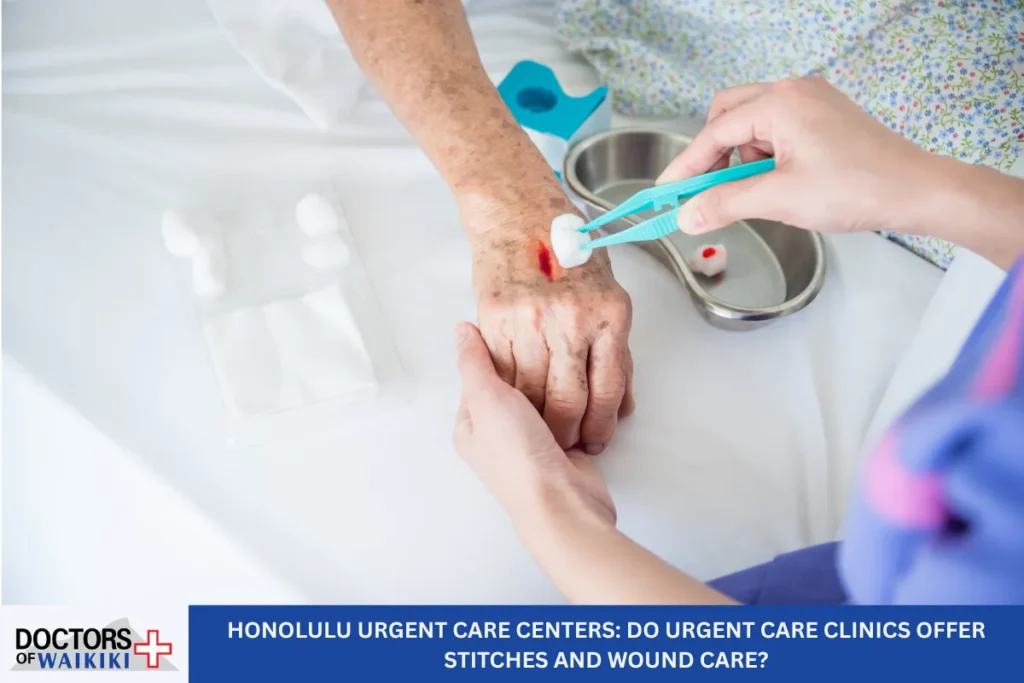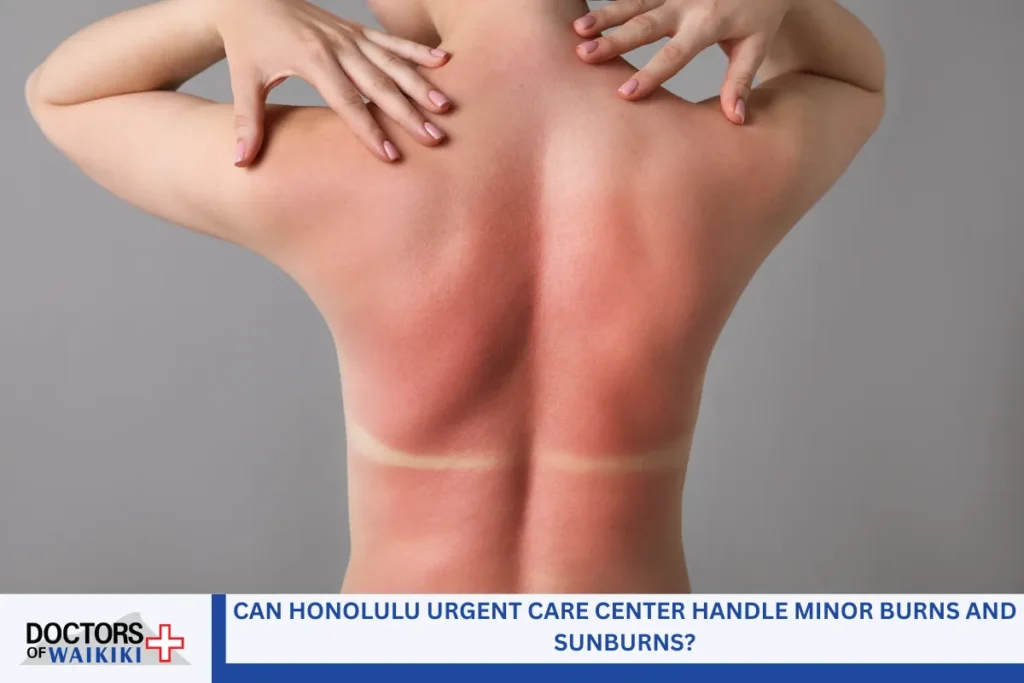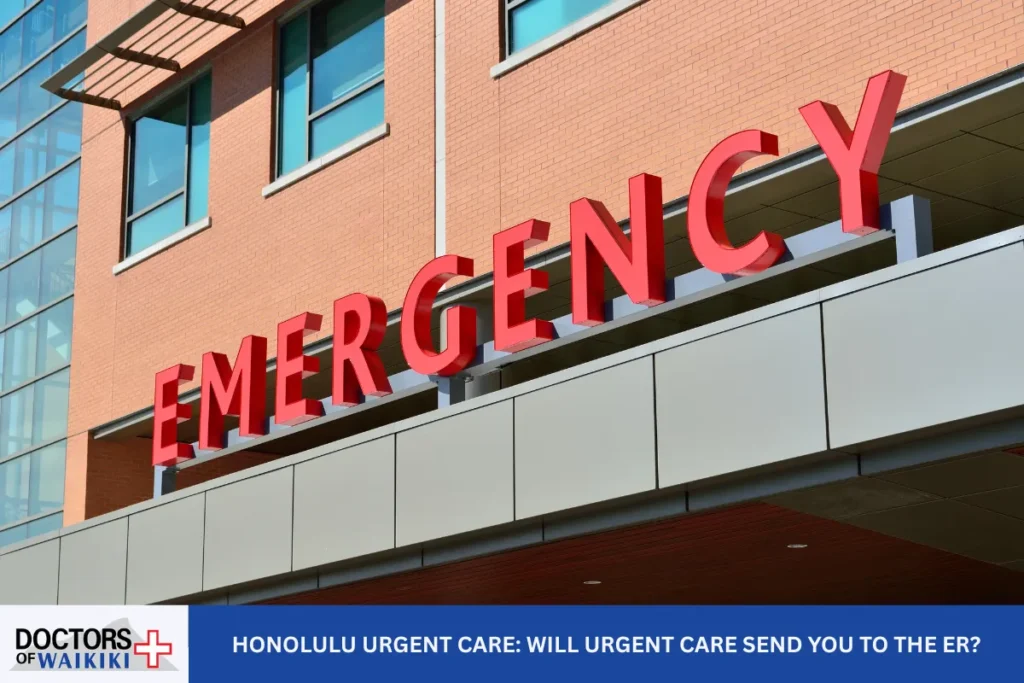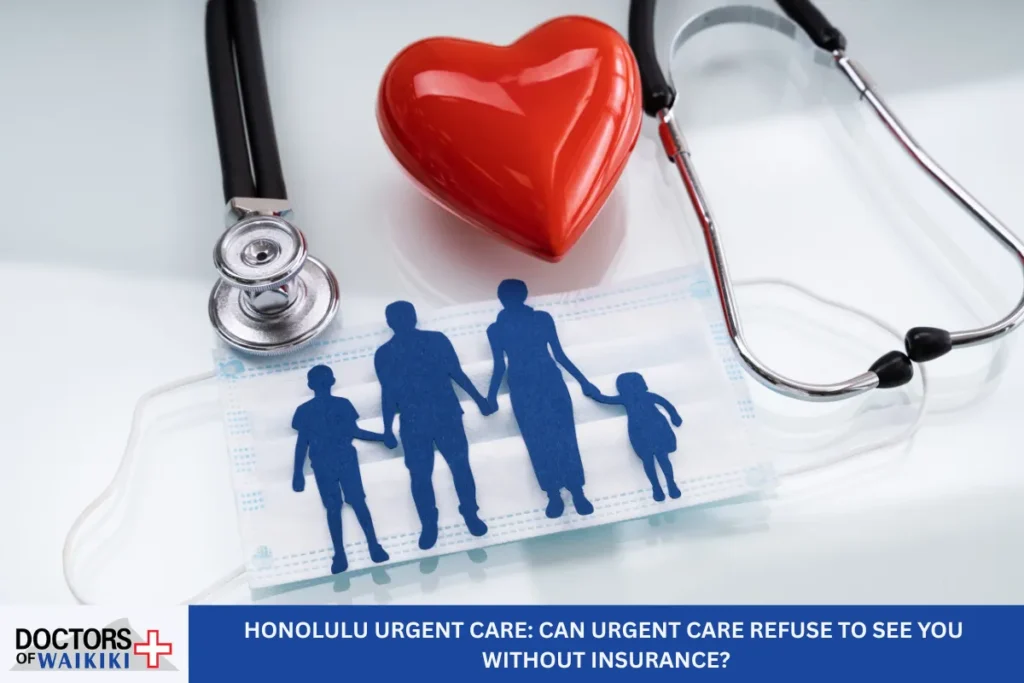Are you searching for Honolulu urgent care centers that can help right away for sudden cuts, wounds, or injuries? Many people worry when they get a cut, gash, or bite wound, asking themselves: Do I need stitches? Should I rush to the ER, or visit an urgent care clinic or walk-in medical clinic instead? If you have an open wound or minor laceration, not knowing where to go can make you anxious.
What if it gets infected or needs urgent wound closure? The good news is, many urgent care centers in Honolulu, Waikiki, and across Oahu, are fully equipped to provide immediate care for a variety of wounds, including stitches, wound cleaning, and aftercare—often with shorter wait times and lower cost than the ER.
In this article, we’ll walk you through everything you need to know about stitches and wound care at urgent care centers in Honolulu, so you can make the safest, smartest choice for your family or while traveling.
What Services Do Urgent Care Centers in Honolulu Offer?
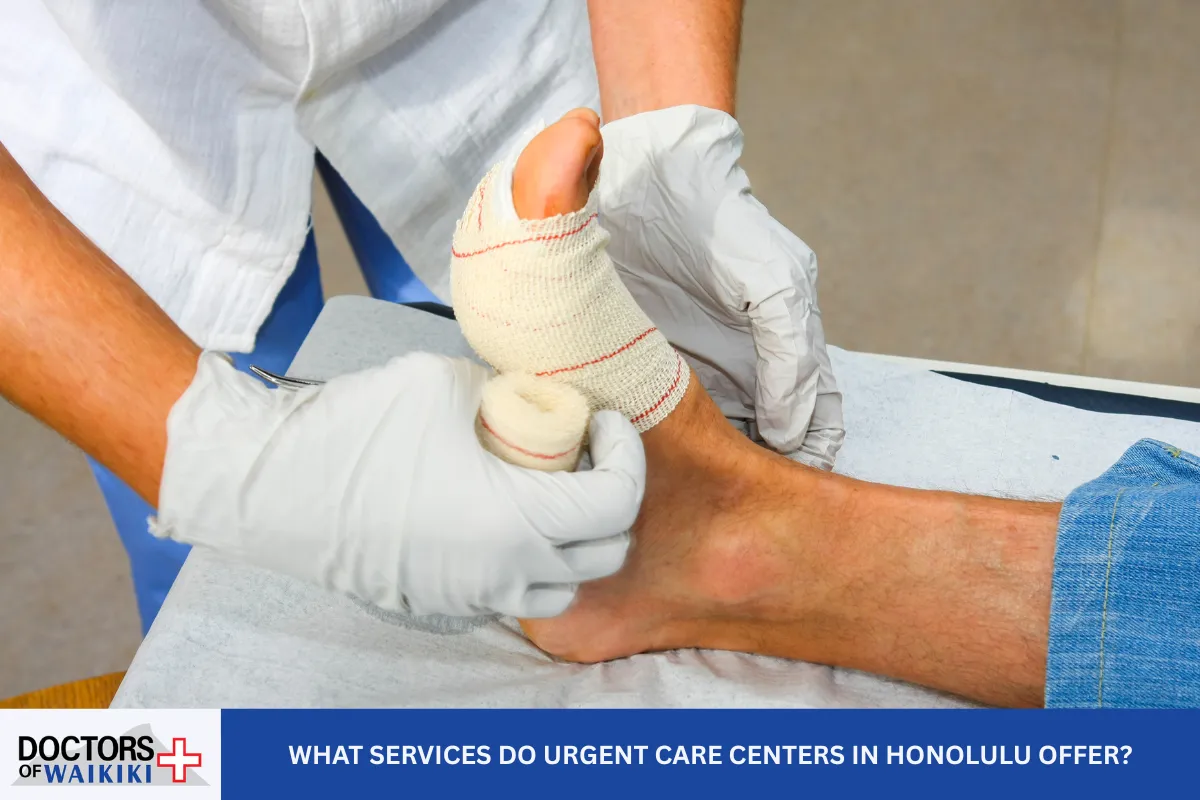
Urgent care centers and walk-in clinics in Honolulu are modern, convenient medical facilities designed to treat non-life-threatening injuries and illnesses without an appointment. These clinics are a great option between your primary care physician and the emergency room, providing rapid, high-quality care right away—including evenings, weekends, and some with 24-hour coverage.
Common conditions treated at urgent care in Honolulu include:
- Minor cuts, lacerations, and gashes (with or without stitches)
- Puncture & bite wounds
- Mild to moderate asthma and allergic reactions
- Sore throats, runny nose, sinus and ear infections
- Pink eye and urinary tract infections
- Minor sports injuries—strains, sprains, bone/joint pain
- Flu, cough, and cold symptoms
- Back, neck, and knee pain, minor orthopedic conditions
- Minor burns and abrasions
- Mild head injury or scalp wounds (after ruling out head trauma)
- Non-severe auto accident injuries and fractures
- Prescription refills and immunizations (like tetanus shots)
- Some offer interpreter services, occupational health, and travel or sports physicals
These urgent care clinics are staffed by board-certified doctors, advanced practice providers, nurse practitioners, and support staff, all trained to evaluate and treat a variety of acute illnesses and minor injuries.
Can Urgent Care Clinics Provide Stitches and Treat Wounds?
Yes, urgent care clinics in Honolulu can—and often do—provide stitches, suture removal, and a range of wound care services. If you’ve got a cut that is more than just a scratch (longer or deeper than a quarter-inch, gaping open, with visible fat/tissue, over joints, or won’t stop bleeding), visiting an urgent care is a smart choice for quick, effective wound healing.
Wound care & laceration repair services available:
- Wound assessment & cleaning (including thorough irrigation and debridement)
- Local anesthesia (lidocaine injections for numbing)
- Wound closure with stitches (sutures), tissue adhesive/skin glue (like Dermabond), Steri-Strips, butterfly closures, or staples
- Removal of foreign bodies (glass, metal, splinters; X-ray may be used to check for anything left inside)
- Bandaging, dressing changes, infection prevention, and aftercare instruction
- Tetanus shots/booster when needed
- Suture removal follow-up visits
- Wound infection care and antibiotic prescriptions
Whether you need absorbable or non-absorbable sutures, urgent care teams have the expertise and tools for most minor and moderate injuries.
Types of Injuries That Can Be Treated at Urgent Care vs the Emergency Room
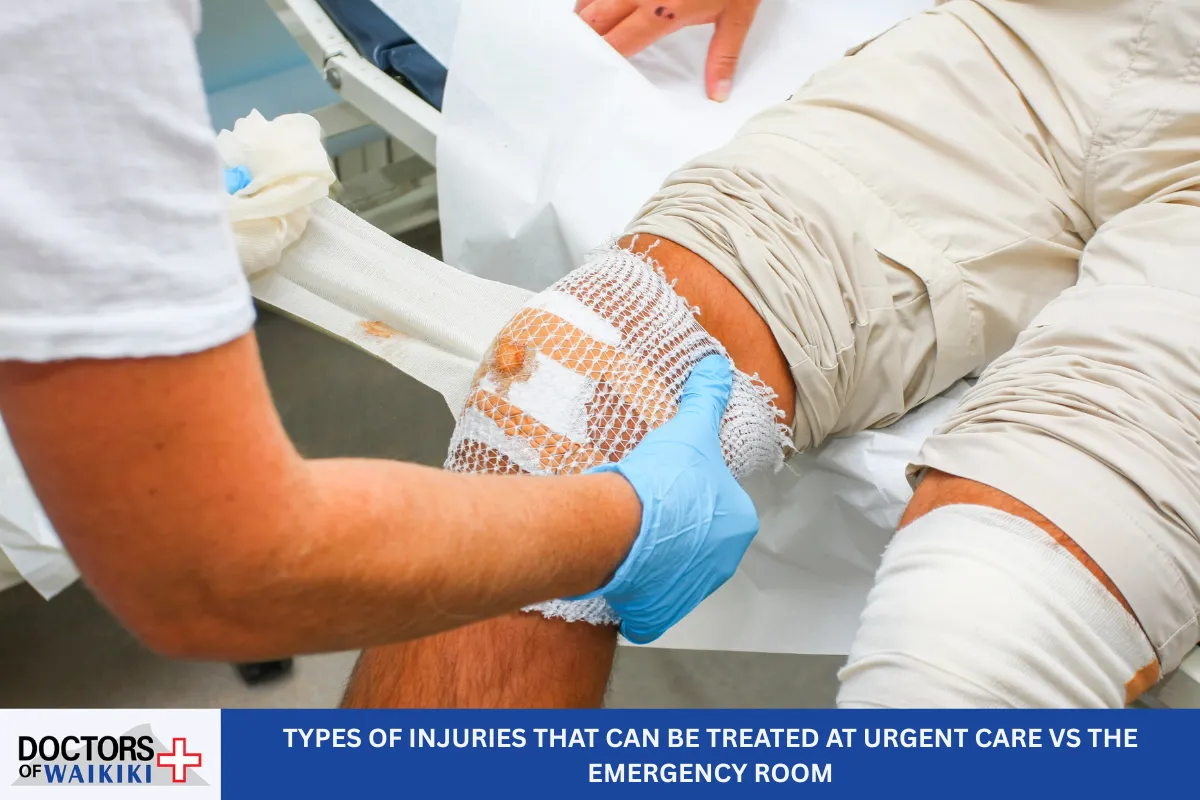
It’s important to know the difference between injuries that are perfect for urgent care, and those that require immediate emergency room (ER) attention.
Urgent care is appropriate for:
- Minor to moderate cuts, lacerations, and abrasions
- Deep wounds that do not expose bone, tendons, or critical structures
- Controlled bleeding (bleeding that stops with 10-15 minutes of direct pressure)
- Facial, scalp, finger/hand, or lip/tongue lacerations that aren’t very large or severe
- Gashes, mild puncture wounds, or animal/human bites (if not extremely contaminated or on the face)
- Foreign bodies that aren’t deeply embedded
- Follow-up for wound checks, suture/staple removal, or infection care
Emergency room care is needed for:
- Severe, uncontrollable bleeding (soaks through towels, won’t stop with sustained pressure)
- Deep wounds with exposed fat, muscle, bone, or tendons
- Evidence of nerve damage (can’t move fingers/toes, numbness)
- Severe wounds to the chest, abdomen, throat, or that affect breathing or vision
- Large or contaminated wounds, major crush injuries, or wounds with embedded foreign objects that cannot be removed safely
- Severe head trauma or possible internal injuries
If you’re ever unsure, it’s safest to call 911 or go to the ER for immediate help.
Read Honolulu Urgent Care: Will Urgent Care Send You to the ER?
Wound Assessment: How Do I Know If I Need Stitches?
Not every cut needs stitches, but it can be tough to tell. Here’s a simple way to recognize when medical attention at a Honolulu urgent care center is a good idea:
Your wound may need stitches if:
- The cut is deep (through all the layers of the skin—fat, tissue, or muscle visible)
- It is longer than a quarter of an inch or gaping open
- Bleeding continues after 10-15 minutes of firm pressure
- It’s located on the face, scalp, hands, joints, or areas where movement will pull the wound open (like knees or elbows)
- It has jagged edges, was caused by a dirty or rusty object, or is at high risk for infection (animal/human bite, puncture)
- There is a foreign object (glass, metal, gravel) that you cannot remove safely
- You have not had a tetanus shot in the last 5 years (especially with animal bites or dirty wounds)
Also seek urgent care if you notice signs of infection: Redness, swelling, warmth, pus, fever, or worsening pain after the initial injury.
Remember, younger children, the elderly, or people with chronic diseases and immune disorders may need more prompt evaluation of even minor wounds.
The Typical Wound Care and Stitches Process at Urgent Care
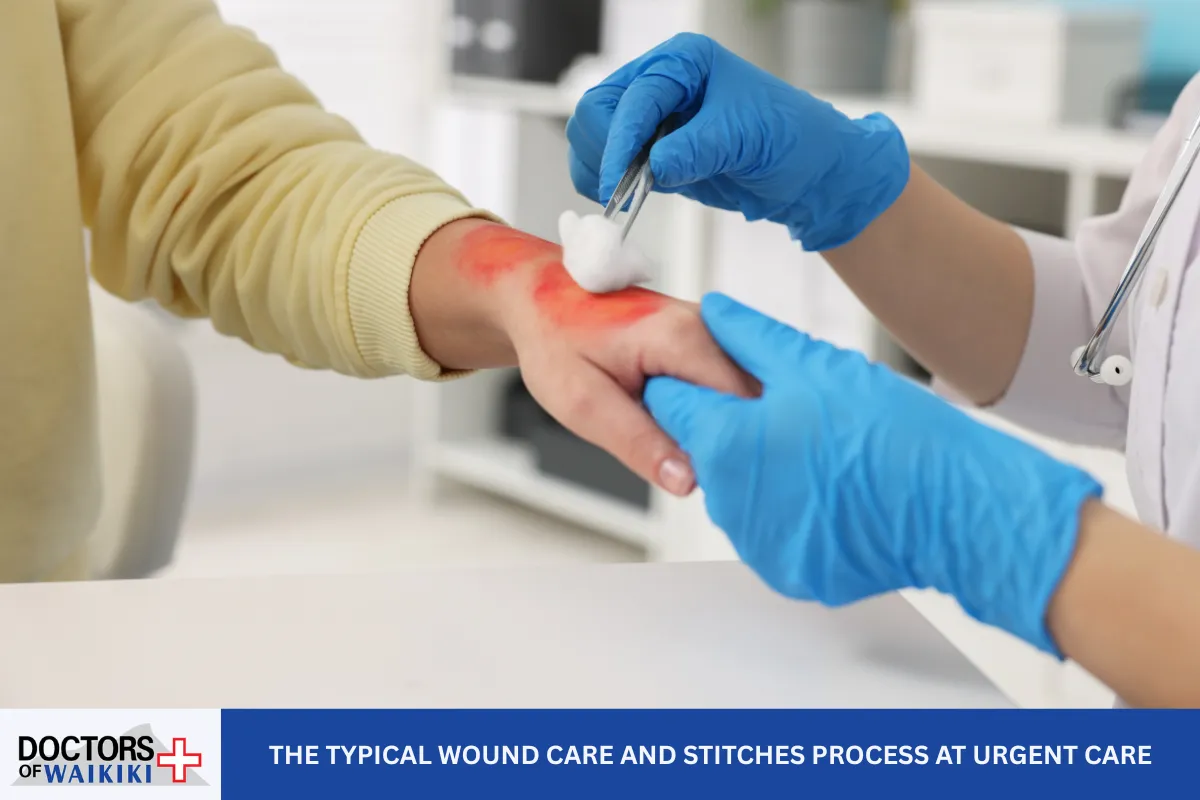
When you visit a Honolulu urgent care center for stitches, here’s what you can expect:
- Triage & Registration
You’ll be greeted by front desk staff; you may need to show your insurance card or travel insurance details.
- Evaluation & Wound Assessment
A board-certified physician or advanced practice provider will examine your medical situation, ask about the injury, assess for tissue damage, infection risk, and decide if you need blood work, X-rays, or other diagnostic tests.
- Wound Cleaning & Preparation
The wound will be cleaned thoroughly (irrigation), sometimes with a local anesthetic (lidocaine) to numb the area. Debridement (trimming dead tissue) may be done to promote wound healing.
- Closure
Depending on the type and location of your cut, the provider may use:
- Sutures/stitches (absorbable or non-absorbable)
- Staples (common for scalp wounds)
- Tissue adhesive/skin glue (Dermabond)
- Steri-Strips or butterfly closures for smaller wounds
- Bandaging & Aftercare
A sterile bandage will be placed, and you’ll get clear aftercare instructions: how to change the dressing, use topical antibiotics or petroleum jelly, signs of healing or infection, when to return for suture/staple removal, and when to follow up with your primary care physician.
- Tetanus or Rabies Prophylaxis
A tetanus shot (Td/Tdap) may be given if your immunizations are out-of-date or the wound is high-risk. In some bite cases, rabies prevention is required.
Cost of Stitches and Wound Care at Honolulu Urgent Care Clinics
One key advantage of urgent care options over the ER is price transparency and cost-effectiveness. For most minor, non-life-threatening injuries, urgent care wound care is much less expensive than hospital ER visits.
- Typical copay: $25-$150 with most insurance plans (verify your health plan coverage before visiting)
- Self-pay rates: $150-$500 or more depending on complexity (simple wound vs. large laceration, use of X-rays or specialty procedures)
- Tetanus shots, laboratory testing, and advanced procedures (like stapling or abscess drainage) may add to total cost
- Travelers: If you have travel insurance, bring details for coverage—many walk-in clinics can bill insurance directly.
Always check with your urgent care center for updated pricing, insurance accepted, patient volumes, and expected wait times.
Timelines for Suture or Staple Removal and Follow-Up Care
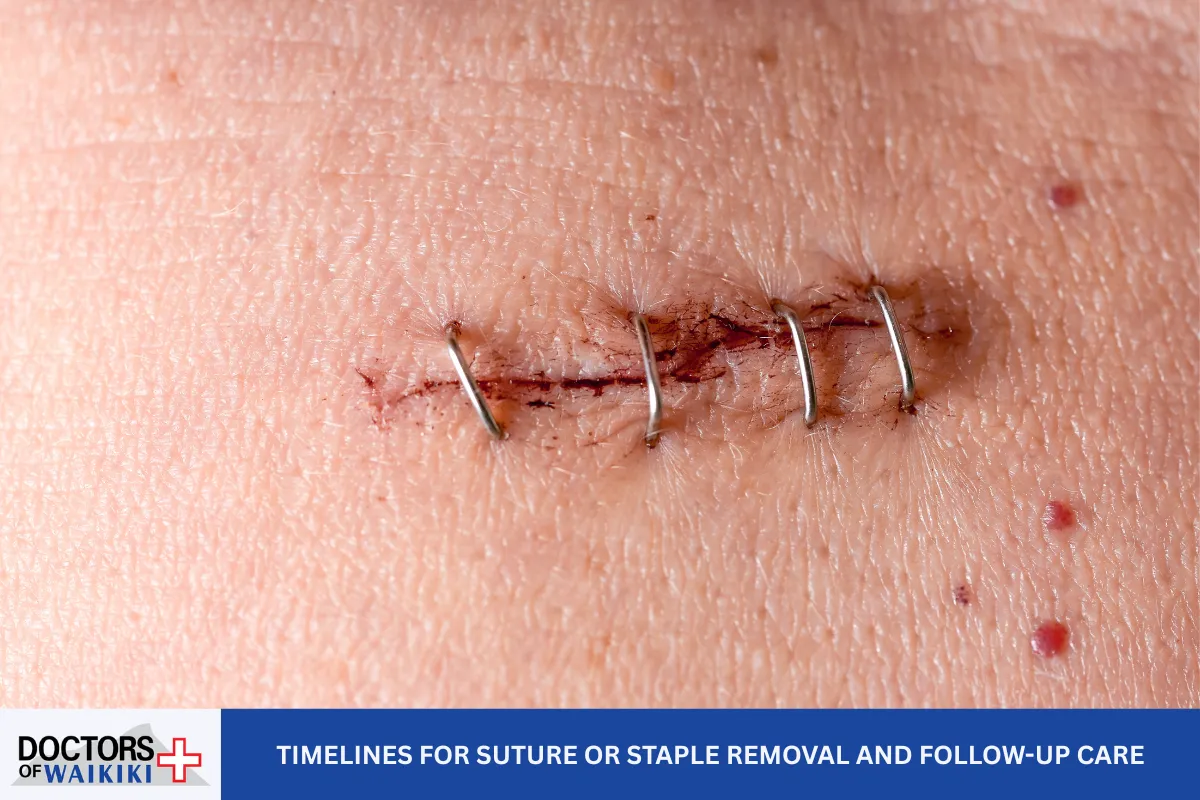
Proper follow-up is crucial for wound healing. Most urgent care centers provide suture-removal or wound checks. Removal timelines vary by body part and wound location:
- Face/lip: 3-5 days
- Scalp: 7-10 days
- Arms/hands: 7-10 days
- Legs/feet: 10-14 days
- Joints: Up to 14 days
You will receive detailed instructions and a printed timeline for your specific wound during your visit.
Special Populations: Pediatric and Travel-Friendly Wound Care
Honolulu urgent care clinics are experienced in treating children (pediatric urgent care) and tourists/travelers in Waikiki, Oahu, and greater Honolulu. Many clinics offer:
- Family care for all ages
- Interpreter services
- Easy walk-in visits or online check-in, with virtual urgent care options for after-hours medical advice
- Help with travel medical documentation, immunizations, and work/school clearance forms
Board-certified physicians and nurse practitioners are trained to provide gentle, comforting care for kids and visitors alike.
What to Do Before Visiting an Urgent Care Clinic for Wound Care
If you or a loved one suffers a cut or wound, here’s what you should do before coming in:
- Apply firm, direct pressure with a clean cloth or gauze for 10-15 minutes to stop bleeding.
- Rinse gently with clean water to remove dirt or debris (do not use hydrogen peroxide or iodine directly in the wound; these can damage tissue).
- Cover with a clean, dry bandage.
- Keep the injured area elevated if possible.
- Bring your insurance card, medication list, and details about your last tetanus shot.
If the bleeding will not stop, the wound is too large for home care, or you feel faint, go to the emergency room or call 911.
Advanced and Specialized Wound Care Options
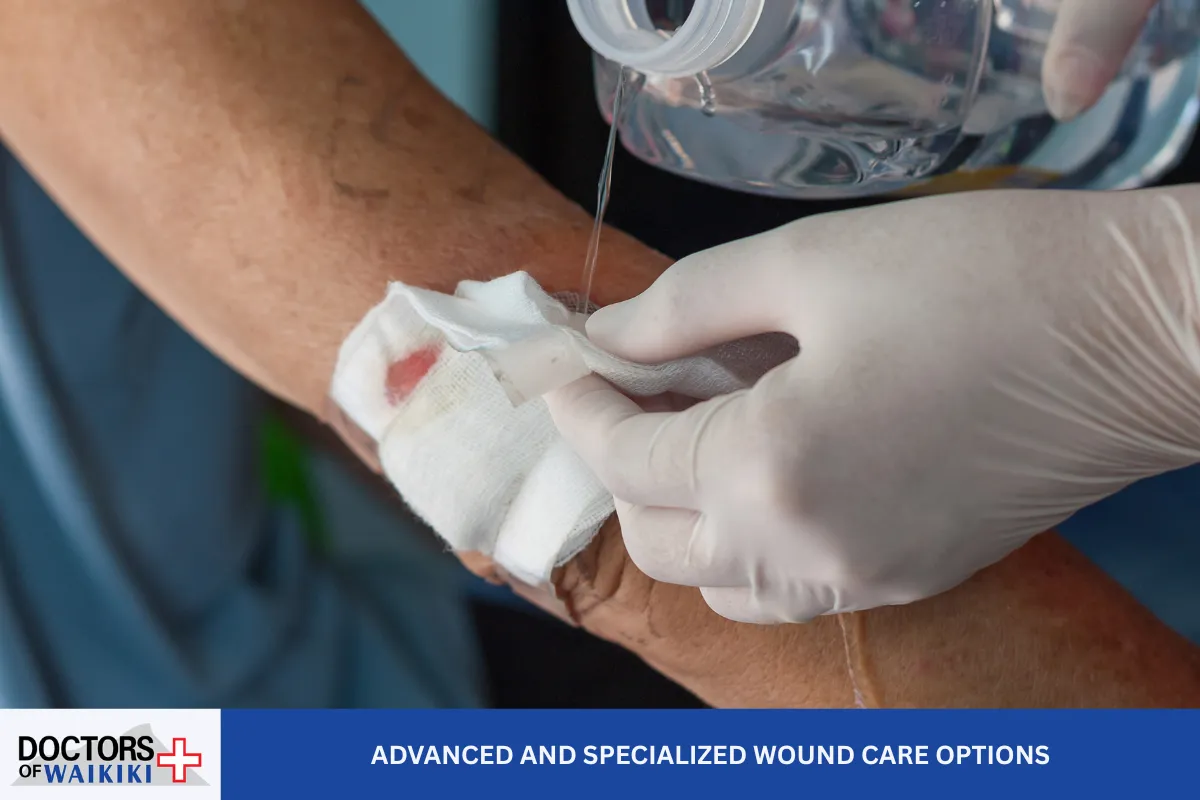
While most minor to moderate wounds can be treated at urgent care with standard stitches, cleaning, and bandaging, certain advanced wounds may require therapies performed at specialized centers or hospitals:
- Negative pressure wound therapy: Sometimes used for chronic wounds
- Hyperbaric oxygen therapy, platelet-rich plasma therapy, or growth factor therapy: Helps some difficult-to-heal open wounds
- Referral to specialists/ER: For severe tissue damage, deep wounds with exposed blood vessels, advanced infections, or orthopedic injury
Urgent care teams will help coordinate your follow-up if these treatments are necessary, ensuring continuity of care with specialists or your primary care physician.
Real-Life Experiences: What Patients Say About Getting Stitches at Honolulu Urgent Care Clinics
Many residents and visitors to Hawaii have shared their experiences with urgent care clinics for stitches or wound care. Most report short wait times, walk in availability, and friendly, skilled providers. Pediatric and adult patients appreciate the clear aftercare instructions, quick suture removal follow-ups, and the convenience of walk-in clinics near hotels or beaches.
Travelers benefit from board-certified providers who are accustomed to treating everything from coral scrapes and glass cuts to minor bites and first aid emergencies—all right in the heart of Waikiki or downtown Honolulu. Many clinics offer diagnostic imaging technology (X-ray, advanced laboratories, lab work) on site, making it simple to check for foreign bodies or deeper tissue damage.
When To Choose Urgent Care Over Emergency Room for Stitches
To sum up, you should choose a Honolulu urgent care clinic for most cuts, lacerations, or puncture wounds that are:
- Not bleeding uncontrollably
- Not exposing bone, muscle, or critical structures
- Free from severe crush injury
- Clean, or only modestly contaminated
- Without severe nerve or tendon injury
If you are unsure, call ahead and describe your injury, and the support staff or front desk at your local urgent care center will guide you. For life-threatening health issues or severe bleeding, always proceed to the nearest emergency department.
Honolulu Urgent Care Centers – Doctors of Waikiki
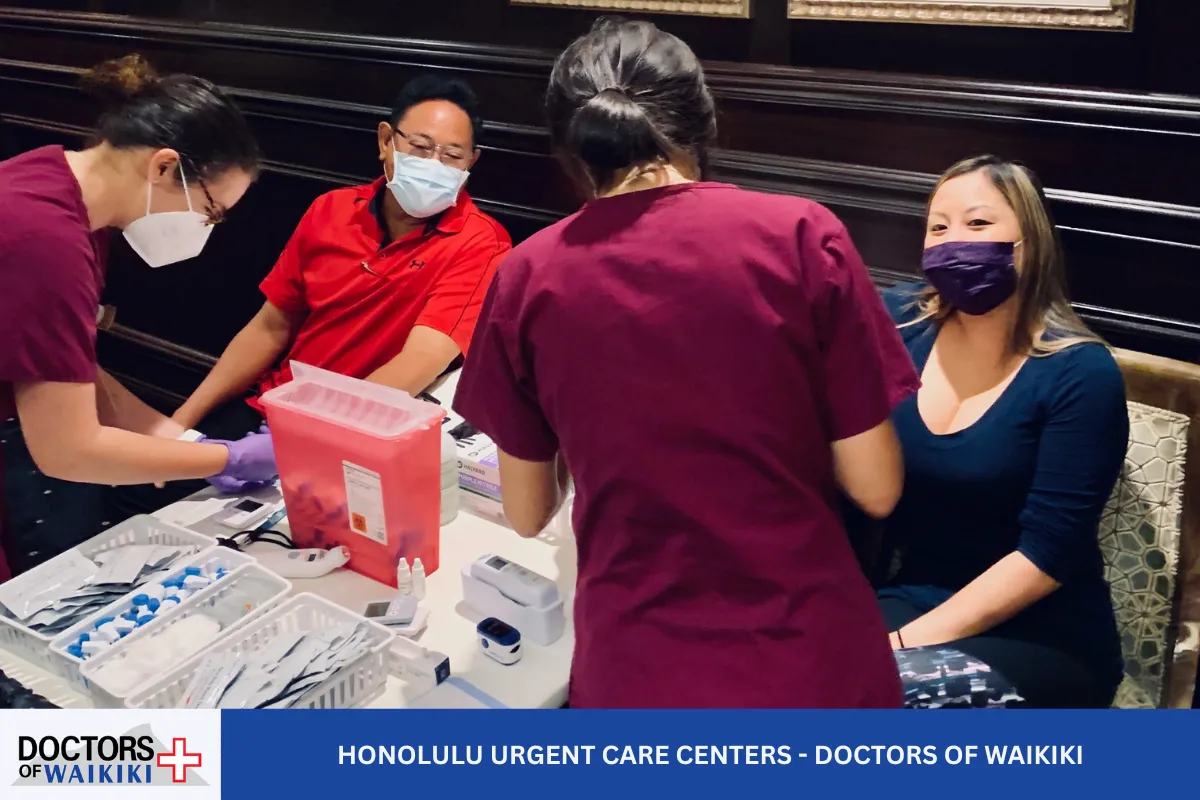
If you need fast, expert care for cuts, wounds, or minor injuries in Honolulu, Hawaii, Doctors of Waikiki is here for you! Our compassionate Urgent Care team provides wound cleaning, stitches, suture removal, and thorough aftercare—right in the heart of Waikiki. Skip long ER waits and high costs; get treated quickly by board-certified providers, even as a walk-in. Whether you live on Oahu or are just visiting, our clinic delivers trusted wound care, tetanus shots, and infection management for all ages, 7 days a week. If you’re looking for quality care at top-rated Honolulu urgent care centers, call us today at (808) 922-2112 to schedule a visit. We proudly serve Honolulu, Waikiki, and all of Oahu!
Frequently Asked Questions
1. Can urgent care centers treat infected wounds, or should I go to the ER for signs of infection?
Urgent care clinics can treat most mild to moderate wound infections, such as those with increased redness, swelling, minor pus, mild fever, or warmth. The provider may prescribe oral antibiotics, perform wound cleaning, or give topical antibiotic ointment as needed. However, if the infection causes severe swelling, spreading redness, inability to move the affected area, very high fever, or systemic symptoms, the emergency room is recommended. Delaying care for signs of a serious infection can result in complications.
2. Does urgent care administer tetanus shots or manage animal bite injuries requiring rabies prophylaxis?
Yes, most urgent care centers offer tetanus shots (Td/Tdap) and can evaluate bite injuries. Tetanus boosters are recommended for most cuts if your last shot was over five years ago, especially with animal or contaminated wounds. Urgent care can also begin rabies post-exposure prophylaxis (PEP) for certain animal bites, though more serious or high-risk cases may require referral to the emergency department for additional monitoring and medication.
3. How long does it take to get stitches at an urgent care center in Honolulu, and do I need an appointment?
For walk-in visits, wait times vary based on patient volumes, but urgent care is generally faster than ERs. Many clinics also offer online check-in or virtual urgent care to reduce your waiting line. The entire process—from check-in to wound cleaning, anesthesia, suturing, and discharge—typically takes 30–90 minutes. No appointment is needed at most walk-in clinics, though calling ahead is helpful during busy periods like flu season.
4. Does urgent care accept insurance for stitches and wound care, and what if I am self-pay?
Most Honolulu urgent care clinics accept major insurance plans, and your health insurance coverage typically includes wound care and stitches. Bring your insurance card to your visit. For patients without insurance or those who prefer to pay out-of-pocket, self-pay rates are generally much lower than the ER, with transparent pricing provided before treatment begins, so there are no billing surprises.
5. Can urgent care handle wound care for children, the elderly, or travelers?
Absolutely. Pediatric urgent care is a standard part of most clinics, and staff are skilled in making children and families comfortable during wound cleaning, stitches, or suture removal. Elderly patients and tourists can expect assistance with translation, travel medicine, immunizations, and proper documentation for insurance or health plan claims. Honolulu and Waikiki urgent care centers are especially prepared to serve visitors with quick access to after-hours and weekend wound care.

